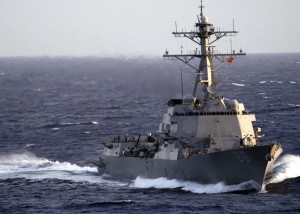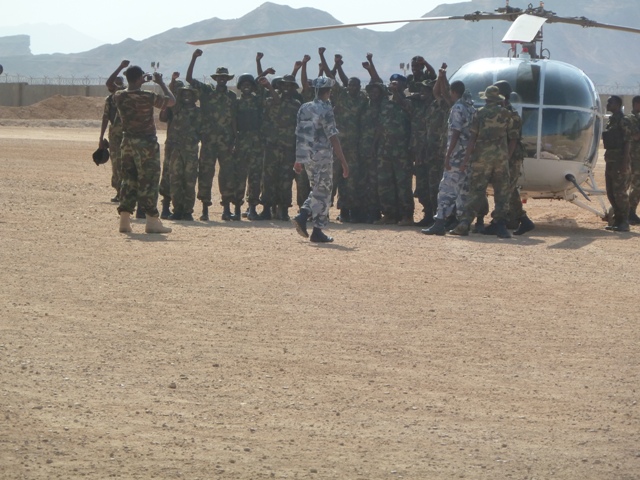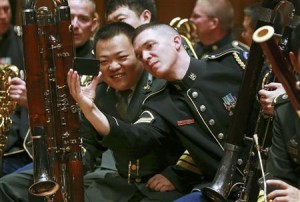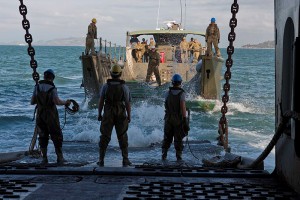
Building on the concepts of Col John Boyd1, the U.S. Navy’s Navy Doctrine Publication (NDP) 6, Naval Command and Control describes the decision-making process as a recurring cycle of observe-orient-decide-act (OODA). A human decision maker that can process this cycle quickly, observing and reacting to unfolding events more rapidly than an opponent, can thereby get inside the opponent’s decision cycle and gain the advantage.
As Boyd noted: “Machines don’t fight wars. Terrain doesn’t fight wars. Humans fight wars. You must get into the mind of humans. That’s where the battles are won.”2
According to NDP-6 the humans that make command decisions at the tactical level are the Composite Warfare Commander (CWC) and his/her principal warfare commanders. The Composite Warfare Commander is the central command authority and overall commander. Under the CWC architecture, the Officer in Tactical Command (OTC) delegates command authority in particular warfare areas to subordinate commanders within the CWC organization including: Sea Combat Commander (SCC), Surface Warfare Commander (SUWC), Undersea Warfare Commander (USWC), Air Warfare Commander (AWC), Information Warfare Commander (IWC), Strike Warfare Commander (STWC), and Mine Warfare Commander (MIWC). To dominate in combat, information has to be integrated, presented to, and easily understood by these humans.
This integration of combat information3 has to occur once and, from all indications, onboard ship in order to realize the advantage of superior information and gain the decision/time advantage. When not in EMCON, this knowledge in the mind of the commander is derived primarily from combat information from tactical unit/force (aka “organic”) sensor systems and, to a lesser degree from sensor systems external to the force. The reverse is the case when operating in EMCON. The integration of combat information from external active and passive sensor systems with information from a tactical force’s passive sensor systems dramatically increases the potential for continued information superiority and tactical advantage.
The Navy Strategy for Information Dominance 2013-2027 contains Objective 3.3: “Integrate all-source information across kill chains”. It states: “Disparate information sources will necessarily span physical locations, security classifications and Navy warfighting domains, but they must be synthesized4 to create actionable knowledge.” The Strategy doesn’t indicate where this integration will occur, or whether sensor information from tactical-force sensors will be included. If integration of only external sensor information, the resulting product would at best be incomplete, at worst misleading, delivered late to the tactical user; and, in a form not suitable for further integration (de-correlation/re-correlation) with information from tactical sensors. If the concept is for organic sensor information to be communicated to some rear area facility for integration with external sensor information and disseminated back to the fleet then there are multiple negative implications. These include communications loading and vulnerabilities, OPSEC considerations, and especially time delays. If presented with two or more separate “pictures of the situation” based on the integration of different sets of information, tactical commanders will still have to mentally synthesize multiple situation awareness inputs – a recipe for misinterpretation, delay and loss of tactical advantage.
As stated in the Strategy:“The Information Dominance pillar can be our most powerful asset, or it can be our greatest liability. If we integrate it intelligently, and if we execute it correctly, we will be able to seize the operational initiative, gain tactical advantage, and win future battles with overwhelming speed.” The “we” has to include not only the Information Dominance Corps, but also the Surface Warfare community and the requirements and acquisitions organizations charged with getting combat systems on surface ships right.
To paraphrase Boyd: Information doesn’t fight wars. Humans fight wars. Information must get into the mind of humans. That’s where dominance occurs and battles are won.
Dick Mosier is a recently retired defense contractor systems engineer; Naval Flight Officer; OPNAV N2 civilian analyst; SES 4 responsible for oversight of tactical intelligence systems and leadership of major defense analyses on UAVs, Signals Intelligence, and C4ISR. His interest is in improving the effectiveness of U.S. Navy tactical operations, with a particular focus on organizational seams, a particularly lucrative venue for the identification of long-standing issues and dramatic improvement. The article represents the author’s views and is not necessarily the position of the Department of Defense or the United States Navy.
1. The OODA Loop was developed by Col John R. Boyd, USAF (Ret), An Organic Design for Command and Control, A Discourse on Winning and Losing. Unpublished lecture notes, August 1987.
2. John Boyd, quoted by Henry Eason, “New Theory Shoots Down Old War Ideas,” Atlanta Constitution, March 22, 1981
3. Joint Pub 2-01: “Combat information: Unevaluated data, gathered by or provided directly to the tactical commander which, due to its highly perishable nature or the criticality of the situation, cannot be processed into tactical intelligence in time to satisfy the user’s tactical intelligence requirements.”
4. Joint Pub 1-02: “Synthesis: In intelligence usage, the examining and combining of processed information with other information and intelligence for final interpretation.”






